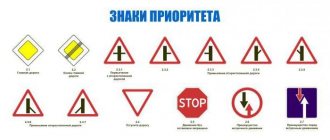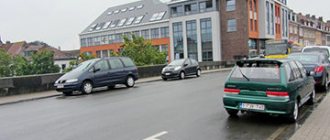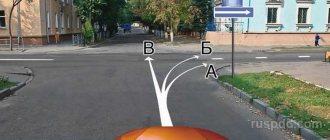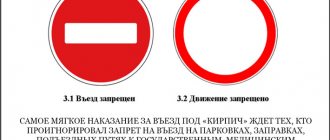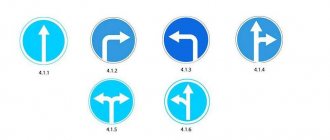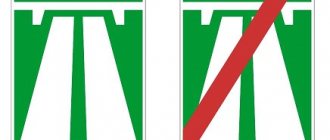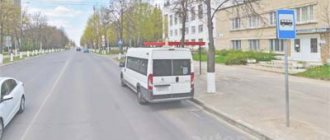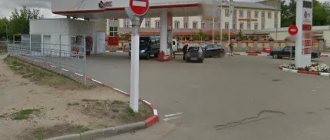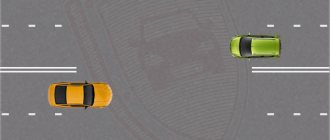Symbol meaning
The “One-way traffic” sign is installed in front of the road, along the entire width of which the movement of any motor vehicles must be carried out in only one direction. Externally, the symbol is presented in the form of a square, with a white arrow on a blue background. Some drivers commit serious violations by confusing it with the mandatory “Go straight” sign. Visually, the symbols are similar, but the latter is presented in the form of a circle with an arrow enclosed in it. It is important to distinguish between them, since they imply compliance with different rules.
A one-way traffic sign marks the beginning of a roadway on which all vehicles must travel in the same direction. In addition, it is also installed at intersections. Namely, at the intersection of parts where at least one road is “single-stream”. In this situation, the installation of the sign is due to the fact that drivers entering this area must timely assess the situation and follow the Traffic Rules.
Explanation
The “One-way traffic” sign, according to the traffic rules, is intended to warn traffic participants about the beginning of a road segment with movement only in the designated direction. According to the established rules, this designation is divided into types:
- 5.5 - One-way road. Designates a section of a roadway or carriageway along which motorized vehicles are allowed to drive across the entire width of the roadway in one direction. Installed at the beginning of a one-way road;
- 5.6 - End of one-way road;
- 5.7.1 and 5.7.2 - Entering a one-way road. Indicates the exit of vehicles onto the roadway or carriageway with one-way traffic.
Sign 5.6 - “End of one-way road”
Signs 5.7.1 and 5.7.2 - “Exit onto a one-way road”
Other signs
The sign with the arrow pointing up is not the only one indicating one-way zones. Other graphic designs are also installed on roadways.
These include:
- Sign "Exit onto a one-way road." Designed for drivers traveling on another roadway. This sign informs them that they are approaching the start of a one-way road. Moreover, it can be seen at an intersection if at least one section being crossed needs to move in one direction. It is important to pay attention to the direction of the arrow. This is the direction you need to turn. Accordingly, you cannot move in the opposite direction. In this case, you will enter the lane intended for traffic in the opposite direction.
- "End of one-way road" sign. Externally, it is the same square and a white arrow depicted on a blue background. But the sign is crossed out with a red line. This symbol is installed at the end of a one-way roadway. It is needed so that drivers can assess the situation and promptly change lanes to the outer lane, so as not to accidentally end up in a lane intended for cars moving in the opposite direction. As a rule, the sign is installed together with the warning symbol “Two-way traffic”.
There is always a sign on the back side of the road called “No Entry,” better known to drivers as a “brick.” Ignoring this symbol in many cases leads to an accident. This is due to the fact that inattentive drivers enter a one-way road, but from the other end, that is, they find themselves in the oncoming lane.
One-way traffic area
Road engineering structures that provide for one-way traffic flow in their traffic organization have certain boundaries. They are usually indicated by a special graphic indicator - “End of One-Way Road” Sign No. 5.6. It is a white arrow depicted on a blue canvas and crossed out by a thick red line.
The termination of the coverage area notifies the driver that he needs to pay special attention to the further continuation of the route, as he will be met by oncoming traffic.
This warning is additionally duplicated in the form of the warning road sign “Two-way traffic” No. 1.21. This technical safety device has a triangular shape, where two arrows facing each other are depicted on a white triangle with a red frame.
A sign warns of the start of a two-way road
Coverage area
You must move in one direction until the corresponding sign appears, canceling the previous one. In this case we are talking about the symbol “End of a one-way road”.
In addition, the sign is valid until the nearest intersection. If a driver is driving along an area that has several roadway intersections, then he should know that on the other side the symbol is no longer relevant. In other words, beyond the intersection, the person driving the vehicle has the right to make certain maneuvers, which are prohibited by default by the “One-way traffic” sign.
Area of operation of the “One-way traffic” sign
Often additional signs are placed that indicate the length of the one-way road section:
- On roads that are divided by routing (under certain conditions);
- at the beginning of the entrance to a one-way roadway.
The main sign 5.5 is installed only at the beginning of the street, where one-way traffic is expected. This sign does not require installation in the following places:
- When the roadway with traffic is separated by a boulevard from the oncoming lane;
- Re-placement of the signpost number 5.5 along the entire path is optional.
After intersections with complex junctions, the sign is installed again under the following conditions:
- For plate 5.6, it is placed in the place where the special regulations indicator 5.5 ceases to apply;
- installed together with warning signs, for example - 1.21 “Two-way traffic”;
- for signs 5.7.1 and 5.7.2, placement is made in front of each side branch of the exit to the street with sign 5.5;
- installation is not required at exit points adjacent to the highway or from section 5.5.
Entry into and exit from the symbol's coverage area
On a single-lane road, special rules apply. They are easy to remember. But, despite this, in reality, very often people driving vehicles have difficulties when entering and exiting a given area.
When the “One-Way Road” sign appears, it is recommended to change lanes to the right. This is the optimal way to travel. In addition, the need to perform certain maneuvers automatically disappears.
In some cases, the following difficulties arise:
- The one-way traffic sign is located behind the intersection, which can only be reached by turning right. In such a situation, you need to leave the intersection and change lanes. In other words, turn right as you would under normal circumstances. After this, the driver has the right to drive on any lane of the road intended for one-way traffic.
- The sign is installed at the left turn. In this case, the algorithm of actions is similar to that described above. Just before starting the maneuver you need to change lanes to the far left.
- Tram tracks are located along the route. In such a situation, access to a one-way road must be made from them. But the vehicle must not interfere with trams. In addition, the maneuver cannot be carried out if there are signs prohibiting it. It is also important to ensure that you do not accidentally end up on tram tracks intended for the opposite direction.
- When leaving a one-way road, you must turn left. To do this, you need to change lanes in a timely manner. However, it is important to remember that until the intersection, traffic continues to be one-way. It is when this maneuver is performed that the largest number of violations are recorded.
It is important to remember that the “One-way traffic” sign is located at the beginning of the right lane of the roadway. It is designed for drivers who continue to drive straight. Or they intend to make a right turn.
Basic signs “One-way traffic” and traffic rules for them
The “One-way road” sign means the beginning of a segment that can be followed strictly in one direction, regardless of the location of the car on the lanes. And it is unacceptable to move towards traffic traveling in the indicated direction.
5.5 is not the only sign that can be seen on such a road. There are other signs that tell drivers what the limit is. The one-way traffic signs in the traffic rules are as follows:
- 5.7.1 and 5.7.2. They show the exit from another trajectory onto a road where it is only allowed to go “there”, but not back. The conditions they establish are the same as those dictated by 5.5.
- 3.1. Imposes an entry ban. It is installed across the street from 5.5. The symbol refers to vehicles that might tend to drive in the opposite direction of the permitted one.
- 5.6. Notifies that the territory where 5.5 was active has ended. And, moving further, the driver can see oncoming traffic. Next to 5.6 there is sometimes a sign 8.1.1, indicating the distance to the road, where cars move in both directions.
- 1.21. Placed at the beginning of a segment where it is allowed to follow in both directions. There may be a 5.6 symbol with it, but not always. If the area regulated by 5.5 is no more than 100 m in size, 1.21 is installed alone.
- 5.11.1 and 5.11.2 . The first one is located where all vehicles are traveling in the same direction, and only route vehicles are traveling towards them. The second means that only cyclists are allowed to move in the oncoming lane. This lane is closed to others.
More on AutoLex.Net:
Important Roundabout Issues
Movement in forward direction
All drivers are required to comply with the terms of the mandatory symbol. Regardless of which “One-way traffic” sign is installed (the beginning of the zone or the exit to this area), the person driving the vehicle must move in the direction indicated on the arrow. That is, in this case, driving in a forward direction is the best option. But there is one caveat. It is important to carefully assess the situation so as not to end up in the lane intended for traffic in the opposite direction.
“One-way road” and “Go straight” signs
The fourth group is the road sign “One-way road” (sign 5.5 of traffic rules) and the sign “Move straight” (sign 4.1.1 of traffic rules). Both signs have a white arrow, which some drivers sometimes confuse, especially inattentive, inexperienced novice drivers who have recently started driving. However, both signs have a different shape: the sign indicating one-way traffic is rectangular in shape.
See also: Leaving the yard: who is inferior to whom
The sign indicating straight ahead is round. The purpose of a sign indicating a one-way road is to inform road users that the flow of traffic on this road can only be in one direction. In the opposite direction, to prevent cars from entering towards one-way traffic, a road sign “No Entry” (sign 3.1 “brick”) is usually installed.
The sign “Move straight ahead” allows movement only straight ahead. You can turn right into courtyards and other adjacent areas. Turning left is prohibited. However, this road sign does not apply to route vehicles. By the way, the sign also applies to intersections. So to avoid confusing these road signs, just learn that a rectangular sign with an arrow indicates a one-way road.
Right turn
In this case, several scenarios are possible:
- The driver should not encounter any difficulties when exiting a one-way road. You must first move into the outer lane and make a turn.
- The driver needs to turn right within the area of the sign. In such a situation, you also need to take an appropriate position and drive into the adjacent territory, for example, into a yard.
Thus, right turns are not prohibited in the area covered by the One-Way Traffic sign. Drivers should not be afraid to carry out this maneuver either at intersections or on less busy roads.
Reversing
The rules for reversing are determined by paragraph 8.12 of the traffic rules. This clause prohibits the following movements:
- in the intersection area;
- at pedestrian crossings;
- in the area of bridges, overpasses, and also under them;
- in the territory of tunnels;
- at railway crossings;
- in areas with poor visibility;
- at stops.
The list is exhaustive, that is, in other places, driving in reverse is not prohibited. Accordingly, you can drive like this if you are within the coverage area of the “one-way traffic” sign. The main thing is that reversing does not interfere with other drivers and pedestrians.
Left turn
The “One-way traffic” sign prohibits this. This is a rule with no exceptions. If the driver is moving in a straight direction, he cannot turn left, since in this case he will inevitably end up in the oncoming lane. This significantly increases the risk of an accident. In addition, the violator in such situations is subject to administrative liability. As practice shows, most often the driver’s license is confiscated from the person driving the vehicle.
What does the one-way traffic sign mean?
Driving on a one-way road in the opposite direction involves the use of appropriate road signs to regulate traffic, the safety of drivers and pedestrians. The installation and purpose of these signs is regulated by the “Traffic Regulations” (Articles: 5.5, 5.7) and state standards that prescribe the appearance of the signs and their location.
Is it possible to appeal the traffic police report if I signed it?
Find out how much you can lose your license for leaving the scene of an accident here.
Read about fines for overtaking under a prohibitory sign at the following link:
- A sign indicating the beginning of a one-way road is the main warning sign in the regulation of such an issue as “traffic on a one-way road in the opposite direction.” The sign is depicted as a thick white stripe with an arrow, located perpendicular to the road and pointing upward (in the appendix to the traffic rules, sign 5.5 “One-way road”). The essence of the sign: indicates that in this place a road begins on which only one-way traffic is allowed.
- The end of a one-way road looks similar to the previous one, but the arrow is crossed out by an oblique red line (there is also sign 5.6 “End of a one-way road”). As a rule, in addition to this road sign, a road sign indicating two-way traffic is installed (there is also sign 1.21 “Two-way traffic”).
- Entering a road where only one-way traffic is provided, if the car was previously moving on another road. Represents a white arrow on a blue background, pointing to the right or left according to the location of the one-way road. Installed at intersections (there are also signs 5.7.1 and 5.7.2 “Exit onto a one-way road”).
- No entry. The sign is a white stripe parallel to the road on a red background - among car owners it is most often referred to as a “brick”. It is installed on the back side of a one-way road (there is also a sign 3.1 “No entry”).
U-turn
This maneuver is also prohibited. This is due to the fact that a driver who turns around will end up in a lane intended for vehicles moving in the opposite direction.
A different situation arises if a person is driving along the road and sees a sign “Exit to one-way traffic.” In this case, two scenarios are possible. The driver has the right to turn right and be within the area of the sign. The start of one-way traffic means that the person can no longer turn around or turn left. He must move in a straight direction or go to the right.
In the second case, the driver may not enter a one-way road. In such a situation, he can easily make a U-turn. This issue causes disagreement among many drivers. They are due to the fact that when turning, the vehicle will inevitably end up in oncoming traffic. However, you need to understand that a turn is a maneuver. It does not imply driving in the oncoming lane. Therefore, this is not a violation.
Which trajectory do the Rules allow you to make a left turn?
| 1. | Only according to A. |
| 2. | Only according to B. |
| 3. | For any reason. |
The “Exit to a one-way road” sign informs that on the roadway being crossed, traffic is carried out not only in the right, but also in the left lane. Therefore, you can turn left along either of the two paths.
Stopping and parking
Drivers have the right to park on both the right and left sides of the roadway. But this is only when we are talking about a populated area, and there are no corresponding prohibitory signs.
Trucks weighing more than 3.5 tons are prohibited from parking on the left side of the roadway. They can only stop for the purpose of loading/unloading. If there is a lane on the roadway designated for the movement of route vehicles, all vehicles are prohibited from parking on the left side. Outside the populated area, the roadside should be used to stop or park. Parking is only permitted on the right side of the roadway.
Stop and reverse
The effect of the “One-way traffic” sign implies not only a prohibition on driving towards the prescribed trajectory and turning around. Other maneuvers also have their own characteristics:
- Stopping and parking are permitted on the right side of the road or on the side of the road in the absence of prohibitory signs. On the left, this can only be done in a city or village. But if we are talking about trucks weighing more than 3.5 tons, only stopping is permissible. Parking on the left edge of the area, along which everyone goes in one direction, is prohibited for this type of vehicle. Sometimes the section is adjacent to the oncoming row, reserved for buses and minibuses. In this common case, other vehicles cannot stop and park on the left.
- Engaging reverse gear and under symbol 5.5 must be performed in compliance with paragraph 8.12 of the traffic rules:
Reversing on a one-way road is not prohibited, provided that this maneuver is safe for road users and, taking into account the current traffic situation, is caused by an objective need (for example, avoiding an obstacle, parking).
But in accordance with it, it is prohibited where it is impossible to turn around. That is, it seems to be on the road with the designation 5.5. In fact, the maneuver here can be performed when it is unavoidable and there is no danger to others. But it is possible that the right to do this will have to be proven to a traffic police officer.
Watch this video on how to make a U-turn at a one-way intersection:
More on AutoLex.Net:
Basic traffic rules: driving in lanes, signs and restrictions, three-lane rules
Reverse
When entering the beginning of a one-way road, many drivers are afraid of the sign. It is important to remember that the symbol prohibits U-turns and left turns. Reversing is allowed. But before performing this action, the driver must make sure that he will not interfere with other vehicles.
The most striking example is the following: a motorist accidentally passed the entrance to the yard on the right and does not know whether he can put the car in reverse and then move into the adjacent territory. This action is permitted and does not entail administrative liability. But first you need to make sure that it is safe to do so.
The situation is different with intersections. At any road intersections, reversing is strictly prohibited. If the driver has passed the desired section, he is obliged to move in a forward direction until it becomes possible to turn right.
Driving under the one-way traffic sign
From symbol 5.5 you are allowed to move in the direction indicated by the arrow. A U-turn is prohibited here, because it involves changing the trajectory to the opposite one. Otherwise the rules are simple:
- you need to follow straight ahead in the same way as before, that is, without changing direction until the sign 5.6 or 1.21;
- if necessary, turn left should be done from the far left lane;
- if you need to go to the right, they also first stand in the extreme right position and after performing the maneuver try to maintain it.
Watch this video about the rules for driving on a one-way road:
More on AutoLex.Net:
The concept of limited visibility and traffic rules when driving along it
Administrative responsibility: penalties
This issue is regulated by the Code of Administrative Offenses (Article 12.16). If a driver violates traffic rules in the area covered by a one-way road sign, he faces a fine. Its size is 5 thousand rubles.
An alternative penalty is the confiscation of the driver's license for a period of at least 4 and maximum 6 months. If the violation is repeated, the driver’s license may be revoked for 1 year.
The choice of punishment is made by the court. In most cases, this authority decides in favor of withdrawing the driver's license.
U-turn on a one-way road
If we take into account the fact that in the area covered by the “one-way road” sign you can only drive straight, we can conclude that turning around will be strictly prohibited. After changing direction, the movement would continue in the opposite direction, which is a direct violation of the established rule.
In the area covered by the “one-way traffic” sign, you are allowed to drive straight and turn right and left unless there is a corresponding prohibition. Other maneuvers will be punished in accordance with current legislation.

